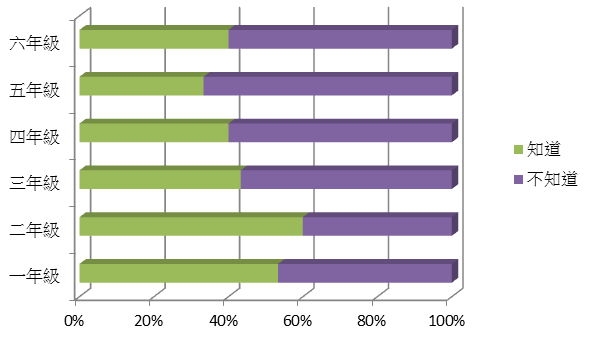| Survey | |||||||
| Because the time and manpower were limited, we adopted the teacher's recommendation to draw 2 to 3 students in each class for six school years to do the survey in order to get a complete sampling. We worked separately to do survey. It was, however, quite challenging to ask the lower graders to fill in the questionnaires because they couldn’t read the questionnaire, not even mention the comprehension of the questions, so we read and explained the questions to them. We could hardly get a questionnaire fill within a single break time. We told the teacher about the condition. Then the teacher came forward asking the home-room teachers to help us doing the survey. We completed it at last. We spent the most time in the low- graders. We got 38 questionnaires in every school year. 31 are valid. The statistic result is as follows: |
|||||||
| Q1:What course have you ever attended? | |||||||
| Life Education | EQ courses | Flying Youth | Small-group counseling | Remedial Teaching | |||
| 184 | 62 | 31 | 16 | 7 | |||
| Q2: Do you know the counseling volunteers need to prepare before giving the courses? | |||||||
| Yes | No | ||||||
| 92 | 94 | ||||||
 Summary: From the results, we know more than half of the students know the
volunteers prepare for the class in advance. But, to take a closer look at the
distribution of all the grades, we found more lower-graders know it than the higher-
graders do. Then we checked and found that the lower-graders think the teachers
and volunteers will prepare for the class. However they were not very sure the
teachers and volunteers will prepare the lessons. Therefore, the number of yes
might be lower. Summary: From the results, we know more than half of the students know the
volunteers prepare for the class in advance. But, to take a closer look at the
distribution of all the grades, we found more lower-graders know it than the higher-
graders do. Then we checked and found that the lower-graders think the teachers
and volunteers will prepare for the class. However they were not very sure the
teachers and volunteers will prepare the lessons. Therefore, the number of yes
might be lower. |
|||||||
| Q3: Do you know the counseling volunteers pay for their learning outside of the school and bring the learning back to share with the other volunteers? | |||||||
| Yes | No | ||||||
| 89 | 97 | ||||||
 |
|||||||
| Q4: How do you think the counseling volunteers give the courses or do the activities? | |||||||
| Very bad | bad | So-so | Good | Very good | |||
| 1 | 4 | 13 | 42 | 126 | |||
| Summary: From the above figures, it’s clear everyone gave much recognition for the counseling volunteers to share with the class through presentations or activities. | |||||||
| Q5: Do you think the volunteers’ sharing is helpful to you? | |||||||
| Strongly Disagree | Disagree | No opinions | Agree | Strongly Agree | |||
| 0 | 0 | 12 | 32 | 142 | |||
| Summary: From the above figures, everyone gave much recognition for the counseling volunteers to share with the class in life education, EQ and the flying youth. | |||||||
TOP |
|||||||






